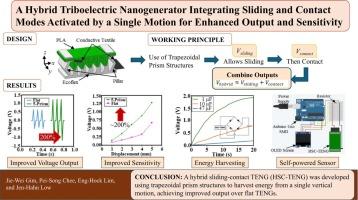A hybrid triboelectric nanogenerator integrating sliding and contact modes activated by a single motion for enhanced output and sensitivity
引用次数: 0
Abstract
Triboelectric nanogenerators (TENGs) have emerged as a promising solution for converting low-frequency ambient mechanical energy into electrical energy, especially from human motion. Hybrid-mode TENGs are gaining increasing attention for their potential to enhance energy harvesting efficiency by combining multiple triboelectric mechanisms within a single device. In this work, a hybrid sliding-contact mode TENG (HSC-TENG) is proposed, integrating both lateral sliding and vertical contact-separation modes, triggered by a single vertical motion. Polylactic acid (PLA) is selected as the positive friction layer, while Ecoflex 0050 is used as the negative layer. These materials enable the fabrication of protruded trapezoidal structures that promote hybrid motion. To fully exploit this geometry, a matching prism-shaped electrode is incorporated. The parallel alignment between the electrode and contact surface enhances charge transfer during both sliding and compression phases. The proposed HSC-TENG achieves an open-circuit voltage of 1.28 V and short-circuit current of 263 nA, with the triboelectric active area of 22.27 cm2, which is 200% higher than conventional single-mode contact-separation TENG. Dynamic testing was conducted to validate the TENG design, demonstrating stable performance and structural robustness over 10,000 continuous operation cycles. The device was further demonstrated in a practical application, successfully charging capacitors and serving as a self-powered button for interactive, sustainable user interfaces.

一种混合摩擦电纳米发电机,集成滑动和接触模式,由单一运动激活,以提高输出和灵敏度
摩擦电纳米发电机(TENGs)已经成为一种很有前途的解决方案,可以将低频环境机械能转化为电能,特别是从人体运动中转化为电能。混合模式的teng由于其在单个设备中结合多个摩擦电机制来提高能量收集效率的潜力而受到越来越多的关注。在这项工作中,提出了一种混合滑动接触模式TENG (HSC-TENG),集成了横向滑动和垂直接触分离模式,由单个垂直运动触发。正摩擦层选用聚乳酸(PLA),负摩擦层选用Ecoflex 0050。这些材料能够制造出促进混合运动的突出的梯形结构。为了充分利用这种几何形状,一个匹配的棱镜形电极被纳入。电极和接触面之间的平行排列增强了滑动和压缩阶段的电荷转移。所设计的HSC-TENG的开路电压为1.28 V,短路电流为263 nA,摩擦电有效面积为22.27 cm2,比传统的单模触点分离TENG提高了200%。进行了动态测试以验证TENG设计,在10,000个连续运行周期中展示了稳定的性能和结构鲁棒性。该装置在实际应用中得到进一步验证,成功地为电容器充电,并作为交互式、可持续用户界面的自供电按钮。
本文章由计算机程序翻译,如有差异,请以英文原文为准。
求助全文
约1分钟内获得全文
求助全文

 求助内容:
求助内容: 应助结果提醒方式:
应助结果提醒方式:


